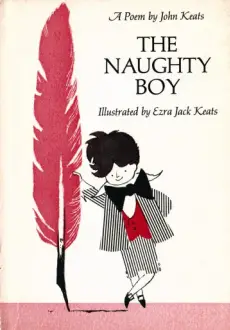“Naughty Boy: A Song About Myself” is a poem by John Keats, one of the principal poets of the Romantic era. Although Keats is best known for his profound odes and sonnets, this particular piece takes a lighter, more playful tone. It’s a depiction of a boy who travels to Scotland and the experiences he faces there. The poem is whimsical and has an element of self-mockery, showcasing a different side of Keatsv
Naughty Boy Song: Penned by one of the most reflective poets, John Keats, this was actually written for children during his trip to Scotland and had sent it to his little fifteen-year-old sister, captured in a letter.
It adds to the amusement of not only children but also adults. Keats had written it as a self-caricature where he is seen as a naughty boy, all packed for his trip to Scotland. He stuffs in a book of vowels and nightcap and a hairbrush and a pair of stockings in case the old ones split. He takes up his bag and follows where his nose leads him. Here, it leads him North.

While writers write for they enjoy writing, readers read with a careful mind. To a particularly avid reader and observer, this poem might hold a metaphorical meaning after all.
This is the story of a boy, wishing to travel the world, packing in his backpack, along with his hairbrush and cap and stockings, all his dreams of watching mountains breathe in the waltzing breeze.
Our little friend, as naughty as he was, nevertheless, had also packed in his book of words and vowels. All he could really do was scribble poetry all day and he kept fishes in tubs in spite of the might of the maid and his Granny.
The wordplay in this poem is a beautiful array of illusion that floats to your ears if you read it aloud. The rhyming scheme has been creatively put in which at one point will either confuse the reader or amuse him. In some cases, it might do both.
“An inkstand
In his hand
And a pen
Big as ten
In the other,
And away
In a pother
He ran
To the mountains
And Fountains
And Ghosts
And Postes
And Witches
And ditches
And wrote
In his coat…”
The beauty of this poem lies in the activities of this naughty boy, who is the world-renowned poet, John Keats. Our little friend travels write and pets a fish and in its simplicity, gives the readers immense joy. This is one of the most celebrated poems of Keats that he had penned for children.
“There was a naughty boy,
And a naughty boy was he,
He ran away to Scotland
The people to see-
There he found
That the ground
Was as hard,
That a yard
Was as long,
That a song
Was as merry,
That a cherry
Was as red,
That lead
Was as weighty,
That fourscore
Was as eighty,
That a door
Was as wooden
As in England-
So he stood in his shoes
And he wonder’d,
He wonder’d,
He stood in his
Shoes and he wonder’d.”
Structure and Form:
The poem employs a simple rhyme scheme and meter, which makes it feel like a nursery rhyme or a lullaby. This choice is intentional, as it complements the poem’s child-like innocence and playful nature. The rhythm and rhyme create a musical quality, which makes it pleasant to read aloud.
Theme of Innocene and Adventure
The poem narrates the adventures of a young boy in Scotland. The boy’s innocence and naive nature are evident in his interactions with the environment and his reactions to the unfamiliar Scottish landscapes. The sense of wonderment and innocence in exploring a new place underscores the entire poem.
Playful Tone
Throughout the poem, Keats uses a playful tone. The boy’s experiences, such as being stung by bees or getting wet in the rain, are depicted in a humorous light. The poem doesn’t delve into deep philosophical musings but stays light-hearted, focusing on the boy’s comical misadventures.
Self-Mockery
It’s widely believed that Keats wrote this poem as a way of mocking himself. The title itself, “A Song About Myself,” points towards self-reference. The naive boy’s experiences in Scotland could be seen as Keats poking fun at his own unfamiliarity and experiences in Scotland. The poem then becomes an introspective piece where Keats reflects on his own nature and experiences, albeit in a light-hearted manner.
Symbolism and Imagery
Keats employs vivid imagery to paint a clear picture of the Scottish landscapes and the boy’s adventures. The “mountains cold” and the “freshening wind” evoke the raw beauty and harshness of Scotland. The bees and the mist serve as symbols of the challenges and surprises that one might encounter in a new place or phase of life.
Conclusion
“Naughty Boy: A Song About Myself” stands in contrast to Keats’s more profound and serious works. It showcases his versatility as a poet, proving that he could effortlessly oscillate between deep, philosophical musings and light-hearted, playful tales. The poem serves as a reminder of the joys of childhood, the thrill of exploration, and the importance of not taking oneself too seriously. It’s a testament to Keats’s ability to find beauty and humor in the simplest of experiences and to transform them into timeless poetry.